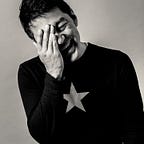The single most important skill for a Chief Creative Officer
Creating an impact as a leader isn’t always about doing big things
Before starting my own company I&CO, I was the Global Chief Creative Officer (Global CCO) of AKQA, an international digital creative agency. I joined the agency back in 2005 (yes, 2005) and spent just a little over a decade there. Prior, I cut my teeth in creative leadership at R/GA, another prominent digital agency, as an Executive Creative Director.
In both situations, I was way too young.
Naturally, I made a lot of mistakes. Some of them were so bad that just thinking about them now makes me want to crawl under a table and hide, even after more than a decade.
“What is the single most important skill for a Chief Creative Officer?”
Carren O’Keefe, a newly appointed CCO at Digitas UK and an old colleague/friend of mine, recently asked me. This is a simple question but not so simple to answer. There are so many skills, qualities, and experiences one should have in order to be a good CCO. Numerous articles, books, videos, classes, and podcasts have been produced on leadership, and quite a few on creative leadership. There’s even an ultimate guide on how to be a Chief Creative Officer on Amazon.
The thing is, all of them are right. For some. None of them are right for everyone. Ultimately, each person needs to figure out what works for them.
This post is just my view and probably won’t be right or even relevant to most. If it is remotely helpful for just one person, that’s all I could hope for.
When Carren asked me the single most important thing for a Chief Creative Officer, many thoughts raced through my mind. Being able to inspire (obvious), being the best creative in the room (arrogant), being a good presenter (too narrow), being a good mentor (a must), seeing what’s coming (no one knows), etc.
Where I landed was this: Humility.
When I was a couple of years into my tenure at AKQA, I was based in San Francisco. There were about 60 people in the creative department that I was leading at the time there. One day, I was getting coffee in the kitchen and saw a young-ish person I hadn’t met before. “Hi, I’m Rei. Are you new?” I asked.
“Oh, hey, I’m ____,” he replied. I then asked him what he did at the company. After he told me he was a copywriter and had just started a few weeks ago, he asked me the following.
“What do you do here?”
This benign question surprised me. Even offended me a little, if I were honest. My first inner thought was “I am your boss’s boss. Possibly their boss as well. I’m the head of the department you belong to. You should know me.” For a split second, I almost said those words out loud.
How young, insecure, and arrogant I was back then.
Quickly, I thought that would be a douchey move because it would make him feel embarrassed. I managed to stop myself. Instead, I told him that I was one of the designers (which was true as I was/am a designer and did a fair amount of hands-on design work). Instead of blaming the newcomer for not knowing his department head, I realized that I hadn’t done enough to make myself visible to him as the department head, and I should have had enough grasp of my own team to know new joiners.
The following week at the department meeting, I told the team that I would stop by their desks every two weeks to say hello to people, one on one, to get to know each person a little. Every two weeks because I was traveling a fair amount at the time and I knew I wouldn’t be able to commit to doing my rounds every week. By announcing it to the department, it was a type of pledge. This gave me a simple routine that I could follow. Or at least try.
For the following 12 months, while I must admit that I did fall short and wasn’t able to see everyone every two weeks, I stuck to this routine, say 75% of the time. Sometimes, people weren’t at their desks, I was traveling and out of the office too much, or just didn’t make enough time to do this routine.
While I’m sure some people didn’t enjoy their boss or (their boss’s boss) checking on them often, to my delight, some people appreciated it more than I thought.
On one visit to someone’s desk—I’ll call him Matt—I noticed he had a digital stickie note on his screen that kept track of which day I came around to his desk. When I pointed that out, Matt said “Oh, yeah” with a slightly devilish grin. He took joy in keeping tabs on his boss.
After one year of doing this, I got to know everyone a little. It gave me a decent grasp of what each person was working on at any given moment. I also believe, perhaps selfishly, that the department got stronger as a team.
There were many lessons I took away from this very simple routine. Most of all, it reminded me of the importance of humility and admitting your fault.
The best way to change the world around you is to start changing the way you behave.
This was a recorded conversation for my podcast “The Creative Mindset.” If you are curious about this and other conversations, please check them out and follow the show wherever you get your podcast:
